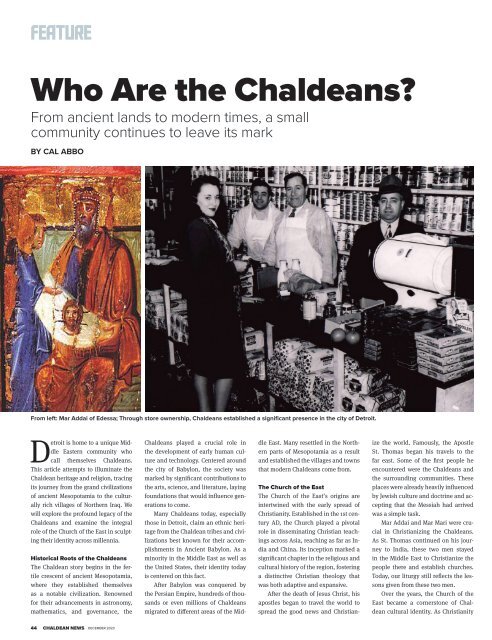Create successful ePaper yourself
Turn your PDF publications into a flip-book with our unique Google optimized e-Paper software.
FEATURE<br />
Who Are the Chaldeans?<br />
From ancient lands to modern times, a small<br />
community continues to leave its mark<br />
BY CAL ABBO<br />
From left: Mar Addai of Edessa; Through store ownership, Chaldeans established a significant presence in the city of Detroit.<br />
Detroit is home to a unique Middle<br />
Eastern community who<br />
call themselves Chaldeans.<br />
This article attempts to illuminate the<br />
Chaldean heritage and religion, tracing<br />
its journey from the grand civilizations<br />
of ancient Mesopotamia to the culturally<br />
rich villages of Northern Iraq. We<br />
will explore the profound legacy of the<br />
Chaldeans and examine the integral<br />
role of the Church of the East in sculpting<br />
their identity across millennia.<br />
Historical Roots of the Chaldeans<br />
The Chaldean story begins in the fertile<br />
crescent of ancient Mesopotamia,<br />
where they established themselves<br />
as a notable civilization. Renowned<br />
for their advancements in astronomy,<br />
mathematics, and governance, the<br />
Chaldeans played a crucial role in<br />
the development of early human culture<br />
and technology. Centered around<br />
the city of Babylon, the society was<br />
marked by significant contributions to<br />
the arts, science, and literature, laying<br />
foundations that would influence generations<br />
to come.<br />
Many Chaldeans today, especially<br />
those in Detroit, claim an ethnic heritage<br />
from the Chaldean tribes and civilizations<br />
best known for their accomplishments<br />
in Ancient Babylon. As a<br />
minority in the Middle East as well as<br />
the United States, their identity today<br />
is centered on this fact.<br />
After Babylon was conquered by<br />
the Persian Empire, hundreds of thousands<br />
or even millions of Chaldeans<br />
migrated to different areas of the Middle<br />
East. Many resettled in the Northern<br />
parts of Mesopotamia as a result<br />
and established the villages and towns<br />
that modern Chaldeans come from.<br />
The Church of the East<br />
The Church of the East’s origins are<br />
intertwined with the early spread of<br />
Christianity. Established in the 1st century<br />
AD, the Church played a pivotal<br />
role in disseminating Christian teachings<br />
across Asia, reaching as far as India<br />
and China. Its inception marked a<br />
significant chapter in the religious and<br />
cultural history of the region, fostering<br />
a distinctive Christian theology that<br />
was both adaptive and expansive.<br />
After the death of Jesus Christ, his<br />
apostles began to travel the world to<br />
spread the good news and Christianize<br />
the world. Famously, the Apostle<br />
St. Thomas began his travels to the<br />
far east. Some of the first people he<br />
encountered were the Chaldeans and<br />
the surrounding communities. These<br />
places were already heavily influenced<br />
by Jewish culture and doctrine and accepting<br />
that the Messiah had arrived<br />
was a simple task.<br />
Mar Addai and Mar Mari were crucial<br />
in Christianizing the Chaldeans.<br />
As St. Thomas continued on his journey<br />
to India, these two men stayed<br />
in the Middle East to Christianize the<br />
people there and establish churches.<br />
Today, our liturgy still reflects the lessons<br />
given from these two men.<br />
Over the years, the Church of the<br />
East became a cornerstone of Chaldean<br />
cultural identity. As Christianity<br />
44 CHALDEAN NEWS <strong>DECEMBER</strong> <strong>2023</strong>
















